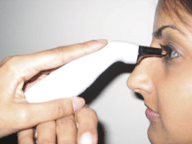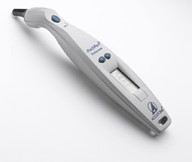Tina Romanay trials a new handheld pachymeter and argues that pachymetry should be a regular technique for optometrists in future.
 Pachymetry is the name given to the technique which involves measuring the thickness of the central part of the cornea. The cornea is approximately 540 to 550 microns thick in the centre, and 1,000 microns thick in the periphery. The most common technique for obtaining corneal measurement is ultrasound due to its availability, accuracy and cost effectiveness. Pachymetry can also be measured by optical low coherence reflectometry.
Pachymetry is the name given to the technique which involves measuring the thickness of the central part of the cornea. The cornea is approximately 540 to 550 microns thick in the centre, and 1,000 microns thick in the periphery. The most common technique for obtaining corneal measurement is ultrasound due to its availability, accuracy and cost effectiveness. Pachymetry can also be measured by optical low coherence reflectometry.
It is becoming an integral part of clinical practice, used for studying the corneal function in a number of medical disease conditions, for example glaucoma, and with various types of refractive surgery.
The Goldmann tonometer (considered to be the gold standard for measuring intraocular pressure) was designed with the assumption that most eyes had a standard corneal thickness of around 520 microns, with little variability occurring in the absence of corneal pathology.
However, in the 1970s, Niels Ehlers MD demonstrated that there was significant variability in corneal thickness and, as a result, corresponding variability of Goldmann tonometry readings.
Results of the Ocular Hypertension Treatment Study (OHTS) in 2002 showed that central corneal thickness (CCT) was an important predictor for those patients with ocular hypertension progressing to glaucoma, with the thinnest corneas conveying the highest risk. The OHTS also indicated that corneal thickness is even more variable than had been previously suspected. Among the 1,636 patients enrolled in the study, most had corneal thickness above normal and over 25 per cent had corneal thickness above 600 microns.
An ultrasound pachymeter uses the principles of A-scan ultrasonography. It provides a convenient means of measuring corneal thickness. To measure corneal thickness, the ultrasonic beam is aligned perpendicular to the central corneal surface. Ultrasonic echoes are obtained from the anterior and posterior surfaces of the cornea. The time interval between the echoes can be used to determine the corneal thickness if the ultrasonic speed of propagation in the cornea is known. 
Register now to continue reading
Thank you for visiting Optician Online. Register now to access up to 10 news and opinion articles a month.
Register
Already have an account? Sign in here
